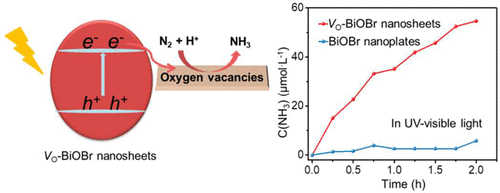当前位置:
X-MOL 学术
›
Nano Lett.
›
论文详情
Our official English website, www.x-mol.net, welcomes your
feedback! (Note: you will need to create a separate account there.)
Oxygen Vacancy Engineering Promoted Photocatalytic Ammonia Synthesis on Ultrathin Two-Dimensional Bismuth Oxybromide Nanosheets
Nano Letters ( IF 9.6 ) Pub Date : 2018-10-12 00:00:00 , DOI: 10.1021/acs.nanolett.8b03655 Xiaolan Xue 1 , Renpeng Chen 1 , Hongwei Chen 1 , Yi Hu 1 , Qingqing Ding 2 , Ziteng Liu 1 , Lianbo Ma 1 , Guoyin Zhu 1 , Wenjun Zhang 1 , Qian Yu 2 , Jie Liu 1, 3 , Jing Ma 1 , Zhong Jin 1
Nano Letters ( IF 9.6 ) Pub Date : 2018-10-12 00:00:00 , DOI: 10.1021/acs.nanolett.8b03655 Xiaolan Xue 1 , Renpeng Chen 1 , Hongwei Chen 1 , Yi Hu 1 , Qingqing Ding 2 , Ziteng Liu 1 , Lianbo Ma 1 , Guoyin Zhu 1 , Wenjun Zhang 1 , Qian Yu 2 , Jie Liu 1, 3 , Jing Ma 1 , Zhong Jin 1
Affiliation

|
The catalytic conversion of nitrogen to ammonia is one of the most important processes in nature and chemical industry. However, the traditional Haber-Bosch process of ammonia synthesis consumes substantial energy and emits a large amount of carbon dioxide. Solar-driven nitrogen fixation holds great promise for the reduction of energy consumption and environmental pollution. On the basis of both experimental results and density functional theory calculations, here we report that the oxygen vacancy engineering on ultrathin BiOBr nanosheets can greatly enhance the performance for photocatalytic nitrogen fixation. Through the addition of polymetric surfactant (polyvinylpyrrolidone, PVP) in the synthesis process, VO-BiOBr nanosheets with desirable oxygen vacancies and dominant exposed {001} facets were successfully prepared, which effectively promote the adsorption of inert nitrogen molecules at ambient condition and facilitate the separation of photoexcited electrons and holes. The oxygen defects narrow the bandgap of VO-BiOBr photocatalyst and lower the energy requirement of exciton generation. In the case of the specific surface areas are almost equal, the VO-BiOBr nanosheets display a highly improved photocatalytic ammonia production rate (54.70 μmol·g–1·h–1), which is nearly 10 times higher than that of the BiOBr nanoplates without oxygen vacancies (5.75 μmol·g–1·h–1). The oxygen vacancy engineering on semiconductive nanomaterials provides a promising way for rational design of catalysts to boost the rate of ammonia synthesis under mild conditions.
中文翻译:

氧空缺工程促进了超薄二维二维氢溴酸铋纳米片的光催化氨合成。
氮到氨的催化转化是自然和化学工业中最重要的过程之一。但是,传统的氨合成的哈伯-博世(Haber-Bosch)工艺消耗大量能量并排放大量二氧化碳。太阳能驱动的固氮技术在减少能源消耗和环境污染方面具有广阔的前景。根据实验结果和密度泛函理论计算,我们在此报道超薄BiOBr纳米片上的氧空位工程可以大大提高光催化固氮性能。通过在合成过程中,加入表面活性剂polymetric(聚乙烯吡咯烷酮,PVP)的V Ô成功地制备了具有所需氧空位和显性暴露的{001}面的BiOBr纳米片,可有效促进环境条件下惰性氮分子的吸附并促进光激发电子和空穴的分离。氧缺陷使V O -BiOBr光催化剂的带隙变窄,并降低了激子产生的能量需求。在比表面积几乎相等的情况下,V O -BiOBr纳米片显示出大大提高的光催化氨产生速率(54.70μmol·g –1 ·h –1),几乎是BiOBr的10倍没有氧空位的纳米板(5.75μmol·g –1 ·h –1)。半导体纳米材料上的氧空位工程为合理设计催化剂以提高温和条件下氨的合成速率提供了一种有希望的方法。
更新日期:2018-10-12
中文翻译:

氧空缺工程促进了超薄二维二维氢溴酸铋纳米片的光催化氨合成。
氮到氨的催化转化是自然和化学工业中最重要的过程之一。但是,传统的氨合成的哈伯-博世(Haber-Bosch)工艺消耗大量能量并排放大量二氧化碳。太阳能驱动的固氮技术在减少能源消耗和环境污染方面具有广阔的前景。根据实验结果和密度泛函理论计算,我们在此报道超薄BiOBr纳米片上的氧空位工程可以大大提高光催化固氮性能。通过在合成过程中,加入表面活性剂polymetric(聚乙烯吡咯烷酮,PVP)的V Ô成功地制备了具有所需氧空位和显性暴露的{001}面的BiOBr纳米片,可有效促进环境条件下惰性氮分子的吸附并促进光激发电子和空穴的分离。氧缺陷使V O -BiOBr光催化剂的带隙变窄,并降低了激子产生的能量需求。在比表面积几乎相等的情况下,V O -BiOBr纳米片显示出大大提高的光催化氨产生速率(54.70μmol·g –1 ·h –1),几乎是BiOBr的10倍没有氧空位的纳米板(5.75μmol·g –1 ·h –1)。半导体纳米材料上的氧空位工程为合理设计催化剂以提高温和条件下氨的合成速率提供了一种有希望的方法。











































 京公网安备 11010802027423号
京公网安备 11010802027423号